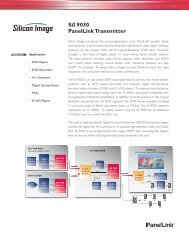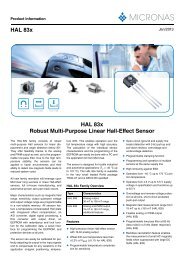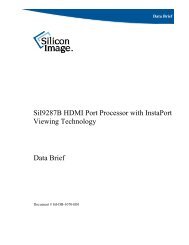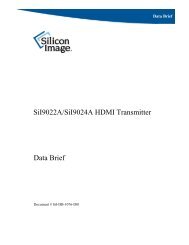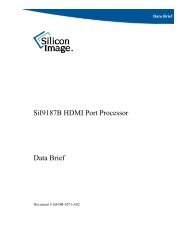D a t a S h e e t - SemiconductorStore.com
D a t a S h e e t - SemiconductorStore.com
D a t a S h e e t - SemiconductorStore.com
You also want an ePaper? Increase the reach of your titles
YUMPU automatically turns print PDFs into web optimized ePapers that Google loves.
7. ENHANCED DATA RATE<br />
EDR has been introduced to provide 2x and optionally 3x data rates with minimal<br />
disruption to higher layers of the Bluetooth stack. CSR supports both of the new data<br />
rates, with WT12. WT12 is <strong>com</strong>pliant with revision v2.0.E.2 of the specification.<br />
7.1 Enhanced Data Rate Baseband<br />
At the baseband level EDR uses the same 1.6kHz slot rate as basic data rate and therefore<br />
the packets can be 1, 3, or 5 slots long as per the basic data rate. Where EDR differs from<br />
the basic data rate is that in the same 1MHz symbol rate 2 or 3bits are used per symbol,<br />
<strong>com</strong>pared to 1bit per symbol used by the basic data rate. To achieve the increase in<br />
number of bits symbol, two new modulation schemes have been introduced as<br />
summarized in Table 18 presented below and the modulation schemes are explained in the<br />
further sections.<br />
Scheme Bits per symbol Modulation<br />
Basic data rate 1 GFSK<br />
Enhanced data rate 2 P/4 DQPSK<br />
Enhanced data rate 3 8DPSK (optional)<br />
Table 18: Data rate schemes<br />
Although the EDR uses new packets Link establishment and management are unchanged<br />
and still use Basic Rate packets.<br />
7.2 Enhanced Data Rate Π/4 DQPSK<br />
4-state Differential Phase Shift Keying<br />
2 bits determine phase shift between consecutive symbols<br />
2 bits determine phase shift between consecutive symbols<br />
S/4 rotation avoids phase shift of S, which would cause large amplitude variation<br />
Raised Cosine pulse shaping filter to further reduce side band emissions<br />
7.3 8DQPSK<br />
Bit pattern<br />
Phase shift<br />
00 Π/4<br />
01 3 Π/4<br />
10 −3 Π/4<br />
11 − Π/4<br />
Table 19: 2 bits determine phase shift between consecutive symbols<br />
8-state Differential Phase-Shift Keying<br />
Three bits determine phase shift between consecutive symbols.<br />
42


